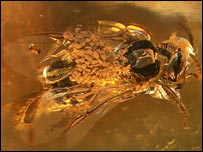amber

Ancient bee trapped in amber.
Amber is fossilized resin formed from prehistoric evergreens. Brownish-yellow and translucent, it is highly valued and can be easily cut and polished for ornamental purposes. Its chief scientific importance is that exquisitely preserved fossil insects up to 40 or 50 million years old have been found embedded in it. The main sources of amber are alluvial soils, in lignite beds, or around sea-shores, especially near the Baltic Sea.
Amber also played an important role in the history of electricity. In about 600 BC the Greek philosopher Thales noted that amber gained the ability to attract feathers, threads, or bits of fluff when it was rubbed with a piece of fur. From the Greek for amber – elektron – comes the name of the subatomic particle whose motion gives rise to an electric current.


